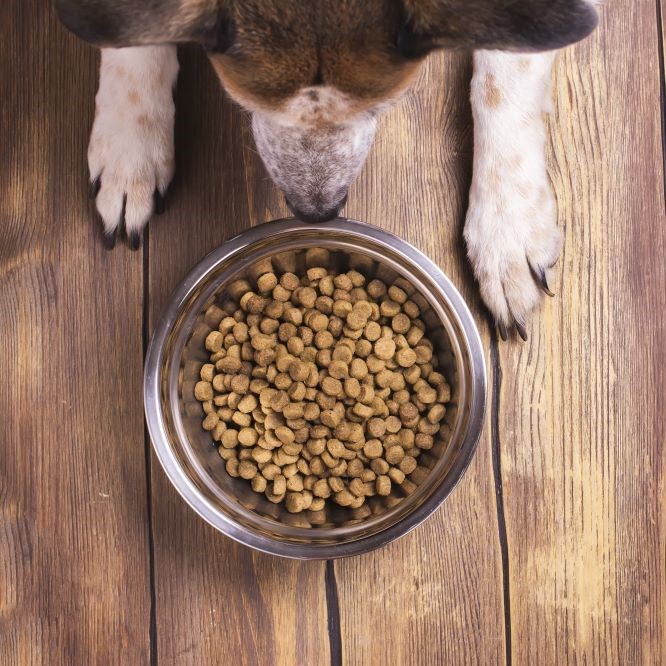Hair coat and skin conditions in dogs
The dog’s skin and hair coat are very important as they protect the dog by forming a barrier between the body and the external environment. Significantly, the condition of the dog’s skin and coat can be a good indicator of his overall health and can even be an early sign of an underlying systemic disease (one that affects other parts of the body or the entire body). Medications, nutritional deficiencies, stress and various other contributing factors can also affect the health of the dog’s hair and skin.
There are around 160 different skin conditions that a dog can suffer from, many of which are very common and some of which are lifelong. Inflammation, parasitic-, bacterial-, fungal- and yeast-infections, abnormal immune reactions, hormonal and metabolic disorders and hereditary conditions can all adversely affect the dog’s skin and coat.
Symptoms relating to and skin and hair conditions in dogs are very broad, but commonly include localised or extensive itching, dryness, redness, sores, scaling, shedding and hair loss, as well as behaviours such as excessive licking and scratching. While they can cause considerable pain and discomfort, most hair and skin conditions are treatable, and the dog will usually make a full recovery.
Continue reading below to learn more about dog skin and hair coat conditions including:
- An A to Z of many of the more common conditions
- Symptoms of hair coat and skin conditions in dogs
- Causes of hair coat and skin conditions in dogs
- Diagnosis of hair coat and skin conditions in dogs
- Prognosis
- Treatment for hair coat and skin conditions in dogs
What are hair coat and skin conditions?
The skin is the largest and most extensive organ of the body, comprising 12 to 24% of a dog’s weight, depending on its species, size and age. Most of the dog’s external layer of skin is covered with a coat of hair, and together the skin and coat provide an effective barrier against the environment.
The skin and coat have many important functions, including:
- Preventing damage to the underlying structures
- Protecting against invasion of micro-organisms and toxins
- Preventing dehydration
- Facilitating the sense of touch
- Enabling the perception of heat, cold, pressure, vibration and pain
- Regulating temperature changes in the body
- Secreting substances that lubricate and act as pheromones, which allow other dogs to recognise it.
The skin has a complex structure of three major layers and multiple types of cells, each with specialised functions. In dogs, skin appendages that grow out of the epidermis, or outer layer of the skin, include the hair follicles, oil and sweat glands and the claws.
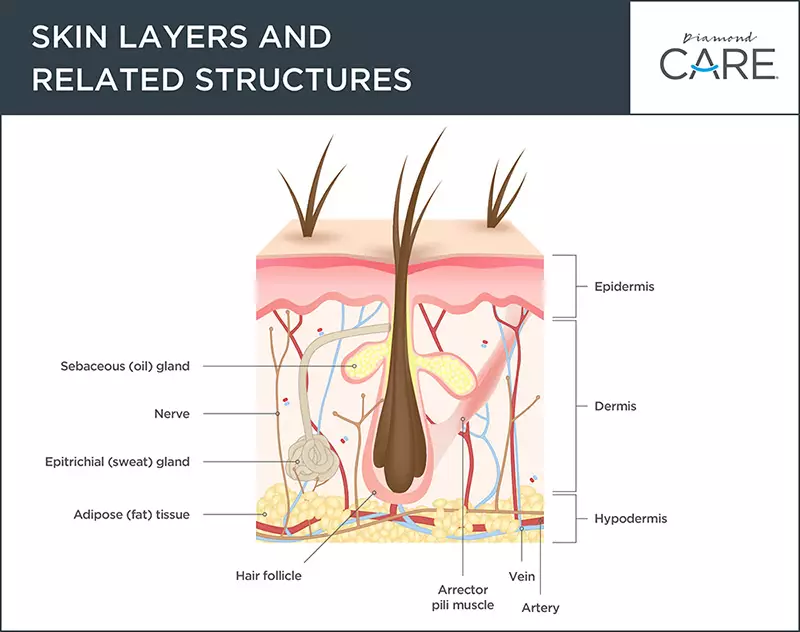
Source: https://www.diamondpet.com/blog/health/sensitive-skin/dogs-skin-coat-layer/
For most dogs, much of the skin is covered with hair. In some breeds hair is shed regularly or, in non-shedding breeds, is constantly growing.
Dogs are born with simple hair follicles that develop into compound hair follicles which produce several different types of hair. Each follicle has a central or guard hair, which is long, thick and stiff, and three to fifteen secondary or under-hairs, which are tiny tufts of hair that provide insulation and softness.
The cold-weather coat of many dogs is long and fine, trapping air between the secondary hairs to conserve heat. The warmer-weather coat usually has shorter, thicker hairs with fewer secondary hairs, allowing air to move more easily through the coat, facilitating cooling.
Because the size, shape, and length of hair are controlled by genetics, different breeds have different coat characteristics:
- Breeds such as smooth-haired terriers and toy poodles have numerous follicles that produce plentiful guard hairs and fewer under-hairs.
- Breeds such as German Shepherds, Airedales and Rottweilers have only half as many follicles but have twice as many under-hairs sprouting from each follicle.
- Other breeds such as Siberian Huskies, Alaskan Malamutes and many of the Retriever breeds have long, thick hair coats with both an outer coat of guard hairs and an undercoat of fine hair that serves as an insulating layer.
- Many short-haired breeds lack a distinctive undercoat and may shed hair in low levels all year round.
Oil glands (or sebaceous glands) within the skin secrete an oily substance called sebum into the hair follicles and onto the skin. Sebum is a mixture of fatty acids which contribute to the sheen of the normal healthy coat and keep the skin soft, moist, and pliable.
The state of health of the animal, as well as the presence of illness, can be indicated by the skin. Healthy skin is supple and clear, and not greasy, flaky, or bumpy. A healthy coat is shiny, smooth, free from dandruff or greasiness and does not shed excessively.
The general coat appearance is often the first indicator of an underlying health problem because hormones, disease, drugs, nutrition, and environment can all affect the health of hair and skin.
Skin, hair and coat conditions are very common in dogs because there are so many factors that can affect the wellbeing of the skin and coat. In fact, there are approximately 160 different types of skin conditions that can affect a dog, some of them being lifelong!
Below is an A to Z covering some of the more common of the many skin and coat conditions, diseases and syndromes that affect dogs.
Acute moist dermatitis, pyotraumatic dermatitis or “hot spots”
These are different terms for the same condition – traumatised areas of skin that have become “hot spots” of intense licking, resulting in sores beneath the haircoat. Usually occurring in dogs with long hair or dense undercoats, it is a common canine skin infection.
It is typically a self-inflicted trauma resulting from the dog’s attempts to alleviate pain or pruritis (intense itching). The dog licks, bites or scratches the area, thereby irritating the inflamed skin even more. The condition is also known as ‘pyotraumatic dermatitis’ because the self-trauma is a major factor in the development of the lesions or hot spots.
Hot spots are typically circular lesions that are moist, raw, inflamed and hairless. They are usually found on the head, over the hip and along the side of the chest, and can change dramatically in size in a very brief period.
Occurring in both inside and outside dogs, hot spots are more prevalent in hot and humid weather and less frequent in the colder temperatures. Many dogs develop several of these lesions over the course of their lives. However, this is not a long-term condition; a lesion may suddenly appear, be treated and disappear in less than a week. Another lesion may suddenly appear a short time later, the following year or may never occur again.
Common underlying causes include a bacterial infection following a minor skin injury, parasites such as mites and fleas, a local allergic reaction to a specific antigen, ear infections, poor grooming, burs or plant awns and anal gland disease.
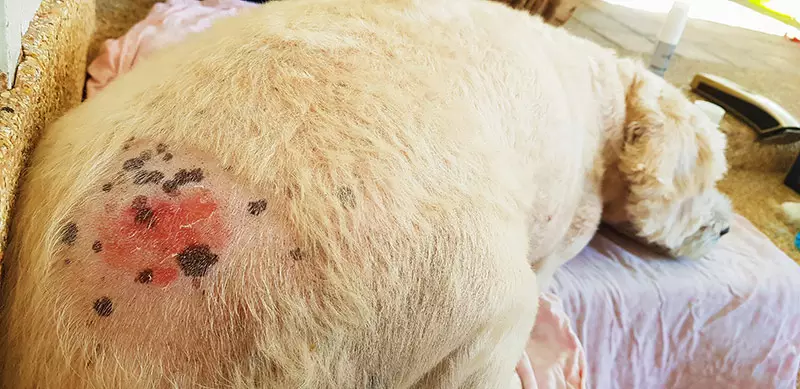
Abnormal skin growth syndromes (hyperplastic and seborrheic syndromes)
These are a group of conditions involving abnormal growth of the skin cells, leading to scaling and thickening of the outer layer of skin. Some of these syndromes are related to the gender of the animal while others are linked to various inherited conditions. Some involve only localised portions of the skin, while others are more generalised.
Abnormal skin growth syndromes include canine ichthyosiform dermatoses, familial footpad hypereratosis, granulomatous sebaceous adenitis, hereditary congenital follicular parakeratosis and soriasiform-lichenoid dermatosis (for more information on some of these conditions, refer to list below).
Acanthosis nigricans
Acanthosis nigricans is a disorder of pigmentation in which there is abnormal darkening, or hyperpigmentation, of the skin. Primary acanthosis nigricans is a breed specific genodermatosis, or genetic skin condition, found primarily in dachshunds that usually presents in dogs less than one year of age. The skin darkens and thickens, seborrhoea (see below) develops, and secondary infections with bacteria or yeast can occur. Large areas of the body may be affected. This condition is rare and is diagnosed mainly through breed history and biopsy.
Secondary acanthosis nigricans is relatively common, has several causes and can occur in any breed of dog and at any age. In this form, the pigment melanin mobilises to areas of chronic inflammation, resulting in the dark appearance of the skin. Hair loss and itching are likely to occur. The disorder may also develop as a secondary stage of another skin disease.
Acariasis
see Mite infestation (mange, acariasis, scabies)
Acquired aurotrichia
Also known as ‘gilding syndrome’, this condition occurs in some Miniature Schnauzers and occasionally in other breeds of dogs. In affected dogs, the primary hairs along the middle of the back above the spine changes from the normal colour to golden. Additionally, the secondary hairs thin out, giving the coat a rough feel to the touch.
Acquired aurotrichia usually starts in young adulthood, at around two and half years. Typically, there are no other changes to the skin and no related health problems. In most dogs, the coat colour returns to normal within two years.
Albinism
Albinism is a rare condition in dogs that is different from extreme white spotting (white areas on the coat). True albinism is a genetic condition in which pigmentation of the eyes, coat and skin is completely absent. Albinism is always accompanied by pale irises (i.e., the coloured part of the eyes is usually pink) and vision defects. Affected animals are at increased risk of skin cancer from sun exposure, especially in areas of skin with short or thin hair.
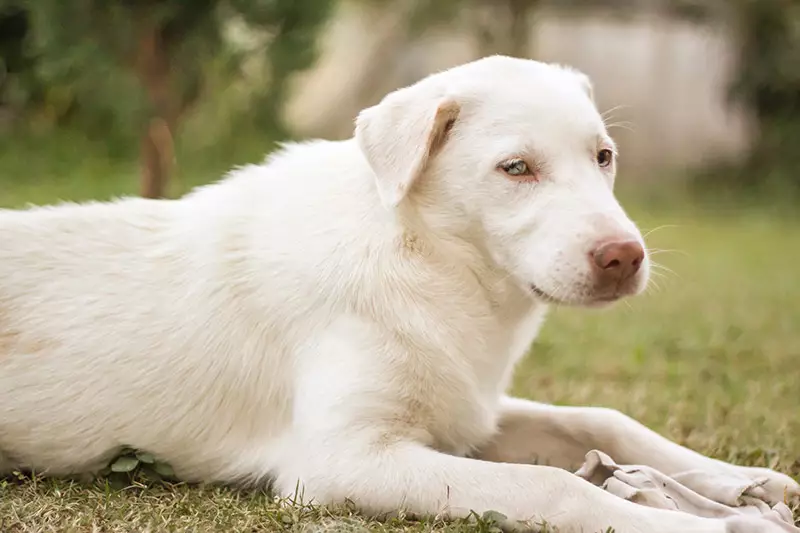
Alopecia
Alopecia, or loss of hair from areas where it normally occurs, is a dog skin condition that can have numerous underlying causes. It can be hereditary or congenital, or it may be acquired. Acquired alopecia often results from intensive scratching or licking of an itchy area (pruritis, or excessive itchiness) as the result of an underlying skin condition such as ringworm (a fungal infection), bacteria, or common skin parasites such as fleas, ticks, mites or lice. This is referred to as ‘inflammatory acquired alopecia’, the most common form of the condition.
Seasonal flank alopecia can appear in Boxers and Airedale Terriers. Various woolly syndromes and post-clipping alopecia can occur in Spitz-type breeds. Reduced hair growth in Irish Water Spaniels develops at 2 to 4 years of age. Another condition called alopecia X occurs in Pomeranians and other breeds.
In cases of hereditary alopecia, dogs may be born either totally or partially without hair. Hairlessness can also develop later in life in dogs that are born with normal coats, with alopecia occurring when the dog sheds its juvenile coat or becomes a young adult. Examples of this condition include pattern baldness in Dachshunds, colour dilution alopecia that is typically seen in Doberman Pinschers, and certain types of follicular disorders.
Certain developmental defects may be associated with alopecia, as well as abnormal teeth, claws and eyes. Hairless breeds have been bred for these defects, but they can also occur in other breeds, particularly in males. Many affected dogs have patchy hairlessness and dental abnormalities, and all are prone to clogging, infection and inflammation of the hair follicles.
Bacterial skin infections (also see pyoderma)
Species of bacteria normally reside on dogs’ skin without causing any problems. However, when the skin is cut or wounded, there is an increased risk of bacteria penetrating the skin and infection developing.
The most common species of bacteria associated with skin infections in dogs is staphylococcus. Signs of bacterial infection are often found in the skin folds, or around areas of broken and irritated skin. These may be red, itchy patches of pustules that seep blood and pus when they break. Severe infections may develop into painful ulcerations and boils.
Bacteria flourish in moist environments, so many dog skin infections are secondary to another condition which adds oil and moisture to the skin, such as a flea, tick or yeast infestation, an allergic reaction, or an underlying disease that depletes the immune system.
Basal cell tumours
Basal cells lie at the base of the epidermis (the top layer of the skin). A basal cell tumour, which is common in dogs and particularly in middle-aged to older dogs, is a benign growth of these cells.
Basal cell tumours develop on the outer layer of skin and appear as firm, elevated, hairless masses, usually around the head, neck, or shoulders. The lumps, which are often hairless or ulcerated, may stick out like stalks from the skin surface and can vary in size from less than 1 cm to more than 10 cm in diameter and are sometimes dark in colour. Cysts may also form.
Although benign, basal cell tumours can be large and may cause extensive ulceration and secondary inflammation, can break the skin, cause the death of skin tissue, and drain fluid or pus. As the dog is often uncomfortable, surgical removal is an effective treatment and reduces the chance of secondary infection and inflammation. Many breeds are predisposed to basal cell tumours, especially Wirehaired Pointing Griffons, Kerry Blue and Wheaten Terriers.
Black hair follicle dysplasia
This is a genetic abnormality of the hair follicles in black and white dogs. It develops shortly after birth and causes almost complete hair loss, but affects only the black-coloured areas. The condition is most common in Papillons and Bearded Collies and is inherited in Large Munsterlanders.
Canine ichthyosiform dermatosis
see Ichthyosis
Collagenous nevi
Common in dogs, these are benign (non-cancerous) nodules or collections of fibrous tissue made up of bundles of collagen. They are flat or raised lumps that develop in the skin itself or in the fat beneath the skin. They are usually found in middle-aged or older animals, most frequently on the legs, head, neck, and areas prone to trauma. Infrequently, some may grow too large to be surgically removed.
Collie nose (Nasal solar dermatitis)
‘Collie nose’ is a condition in which breeds with little or no pigment on their faces develop lesions, usually on the nose, eyelids and adjacent areas, and occasionally on the haired bridge of the muzzle. The lesions appear as pink, raw areas around the nose and on the eyelids which may ulcerate and develop a crusty scab-like covering. The condition can vary from mild irritation to severe ulcerating lesions that crack, bleed and impair breathing.
Collie nose is thought to be caused by a hypersensitivity to solar radiation or sunlight (hence the term “nasal solar dermatitis”). It is more prevalent in areas with sunny climates, and lesions are worse in the summer months. Despite the name, breeds other than Collies can also be affected, especially Shetland Sheepdogs, German Shepherds and mixed breeds closely related to these breeds, suggesting a genetic predisposition. Exposure to sunlight should be severely curtailed in affected animals.
Colour dilution alopecia, colour mutant alopecia
This is a genetic condition affecting the hair follicles which typically causes hair loss in dogs with blue (dilute black) or fawn (dilute brown) coat colours. Most affected dogs are born with normal hair coats, but during their first year they begin to develop hair follicle inflammation, brittle hair and progressive, patchy hair loss in the blue or fawn-coloured areas of the coat, resulting in a ‘moth-eaten’ appearance (other areas remain normal).
This disorder is most common in Doberman Pinschers but also occurs in other breeds including colour dilute Dachshunds, blue Chow Chows, Greyhounds, Whippets, Poodles and Great Danes.
Cutaneous asthenia (also known as dermatosparaxis or Ehlers–Danlos syndrome)
This is a condition in which the skin does not produce enough collagen (a protein that gives structure to the skin), resulting in loose, stretchy, fragile skin that hangs from the body, and associated joint and eye problems.
The fragile skin is evident from birth, while older animals develop hanging folds of skin and exhibit extensive scarring. Wounds heal slowly or not completely, and cysts and bruising may develop. The disease is not fatal in dogs.
Cutaneous mucinosis
In this condition, there is an abnormal accumulation of a protein called mucin in the skin, causing pronounced folding and blisters of the skin in some young dogs. As these dogs mature, the syndrome often becomes less severe, with many dogs seeming to outgrow the condition by around 5 years of age. It is thought to be a familial problem in some lines of Chinese Shar-Peis.
Cutaneous papillomas (warts)
Warts are generally caused by papillomaviruses that are thought to be transmitted by direct contact with infected animals or indirect contact with contaminated objects, such as bedding. They usually occur on the dog’s face including the lips, tongue, inside of the mouth, and eyelids.
A wart is typically a hardened, light-coloured bump with a cauliflower-like appearance. Multiple warts are more commonly seen in younger dogs, and single warts are more common in older animals. Warts caused by viruses are usually benign and will generally disappear on their own within several weeks or months.
Dermatitis or inflammatory disease
Dermatitis is a general term for skin inflammation of any type, rather than a specific diagnosis. It typically manifests as red, scaling, thickened skin characterised by itching, hair loss, abnormal smell and/or oiliness. It may progress to crusting, scaling, boils, blisters and other consequences of long-term inflammation; secondary bacterial and yeast infections often develop.
The numerous possible causes of dermatitis include external agents acting as irritants or allergens to the dog’s skin, bacterial, viral, parasitic and fungal infections, burns, trauma and many internal, systemic diseases. Types of dermatitis common in dogs are exfoliative dermatoses (see below), contact dermatitis, flea allergy dermatitis, atopic dermatitis and pyoderma.
For more information, see our article Dermatitis in dogs and cats.
Dermatophytosis (ringworm)
This is the medical term for the fungal infection affecting the top layers of skin and hair that is more commonly known as ringworm. The organisms that are responsible are not worms at all but the fungi Microsporum canis, Trichophyton mentagrophytes, and Microsporum gypseum.
Ringworm usually appears as circular areas of hair loss throughout the body. These lesions may start to heal in the centre as they enlarge, creating a patchy appearance, and may become inflamed or scabbed. It is diagnosed more commonly in young dogs than in adults.
Dermatosparaxis
Dermoid cysts
Usually found on skin above the backbone, dermoid cysts are skin pockets into which dander, hair, oil, and other debris accumulate. They are congenital (birth) defects that are most commonly found in Boxers, Kerry Blue Terriers and Rhodesian Ridgebacks. While they can be solitary or multiple, most dermoid cysts are multiple and contain fully formed hair shafts. Although they are benign, they can be surgically removed if desired.
Ehlers–Danlos syndrome
Elbow calluses
A thickening of the skin at the elbow, calluses frequently occur in giant, short-haired breeds of dogs that sleep on hard surfaces such as wood or concrete. The callus forms to protect the bony elbow from pressure or trauma whenever the dog lies down. They can become infected and may bleed.
Epidermolysis bullosa (EB)
This is a rare, hereditary, congenital defect of the collagen gene that affects the attachments between the outer and inner layers of the skin, resulting in blistering of the skin. The disease is usually fatal, with many affected puppies not living past 3 months of age.
In affected dogs, blisters may be present at birth or develop within the first weeks of life. Minor skin trauma results in separation of the skin layers. Blisters form and soon rupture, leaving painful erosive lesions. The most severe blisters are on the feet, mouth, face, and genitals.
Several forms of epidermolysis bullosa have been reported in Collies, Shetland Sheepdogs, Toy Poodles, German Shorthaired Pointers, Golden Retrievers, Akitas, mixed breed dogs, and possibly Beaucerons.
Exfoliative dermatoses
Exfoliative dermatoses are a group of inflammatory skin disorders that are characterised by the excessive shedding of skin cells (flaking, scaling skin or dandruff); the term “exfoliative” refers to exfoliation, or shedding. There are many underlying causes of these conditions, from stress to nutritional deficiencies to allergies.
Dogs of any breed or age can be afflicted; however, it appears to occur more frequently in very young or old dogs and those that are immunocompromised or living in poor conditions. Specific breeds are reported to be more susceptible, including Chow Chows, Poodles, Cocker Spaniels, West Highland White Terriers, English Springer Spaniels, Basset Hounds, Irish Setters, Doberman Pinschers, Labradors and Golden Retrievers.
Familial footpad hyperkeratosis, hereditary footpad hyperkeratosis (HFH)
This is an inherited condition in which there is increased thickness of the hard, outer layer of the skin of the paw pads. All footpads are affected from an early age, although the disease is not usually congenital (present at birth). When hyperkeratosis is severe, horns, cracks (fissures) and secondary infections occur, causing pain and lameness. No other skin abnormalities occur.
Certain breeds appear genetically prone to developing familial hyperkeratosis. It has been reported in several dog breeds, such as the Kromfohrlaender, the German Hunting Terrier, the French Mastiff and the Irish Terrier.
Fibromas
Fibromas are isolated, generally raised, often hairless lumps originating under the skin surface, usually appearing on the head and legs. They feel firm and rubbery (fibroma durum) or soft and mushy (fibroma molle) and may resemble collagenous nevi or skin tags.
Fibromas occur in all breeds but are primarily a tumour of aged dogs. Doberman Pinschers, Boxers, and Golden Retrievers are most susceptible. While these tumours are benign, surgical removal is recommended if they change appearance or grow large.
Granulomatous sebaceous adenitis
This hereditary skin condition destroys the dog’s oil glands and, in some breeds, is associated with a severe oil discharge and hair loss. First appearing when the dog is a young adult, it occurs in Standard Poodles and possibly in Akitas. Early signs are a noticeable skin thickening, followed by the loss of normal hair kinkiness, and then progressing to patchy hair loss.
Hamartomas
see Skin tags
Haemangioma
Haemangiomas are small masses of blood vessels that appear as single or multiple, circular, often compressible, red or black lumps, resembling a “blood blister.” It is in fact a benign vascular (blood vessel) tumour of the skin in adult dogs, originating either in the dermis or the subcutaneous layer of the skin and most often occurring on the legs and trunk.
Although they are harmless (benign), they tend to develop ulcers, and can grow quite large. They are common in dogs and many breeds are considered to be at risk, including Gordon Setters, Boxers and Airedale, Scottish, and Kerry Blue Terriers.
Hereditary congenital follicular parakeratosis
This is a newly recognised syndrome in which there appears to be a severe defect of the process that forms keratins, a major component of skin. This syndrome is associated with various abnormalities in other areas of the body and affects female Rottweilers and female Siberian Huskies.
Hereditary footpad hyperkeratosis (HFH)
see Familial footpad hyperkeratosis
Histiocytoma
A histiocytoma is a benign but common skin tumour that typically occurs in dogs younger than three-and-a-half years, although it can occur in dogs of any age. It originates in the Langerhans cells, which are immune cells that function to provide protective immunity to the tissues that are in contact with the outer environment, particularly the skin’s surface. These tumours are benign and are not considered to be a health risk.
While they can appear on any location on the body, most histiocytomas appear on the head, ears, and limbs. The tumour appears rapidly as a small, solitary, raised, hairless, and round lump that is freely movable. It will often ulcerate and then become smaller and go away. The breeds that appear to be most at risk are English Bulldogs, Scottish Terriers, Greyhounds, Boxers, and Boston Terriers.
Hot spots
Ichthyosis, canine ichthyosiform dermatosis, “fish scale” disease
The term “ichthyosis” comes from the Greek word for fish, as the skin of these dogs resembles fish scales. In this rare genetic condition, the dog’s body is covered with thick, greasy scales that may flake off in large sheets. The nose and footpads may be noticeably thickened, causing discomfort.
Ichthyosiform dermatosis occurs intermittently in certain breeds, including Doberman Pinschers, Rottweilers, Irish Setters, Collies, English Springer Spaniels, Cavalier King Charles Spaniels, Golden Retrievers, Labrador Retrievers, American Bulldogs and terriers. There appears to be a familial inheritance pattern for this condition in Jack Russell Terriers and Golden Retrievers.
Impetigo
see Pyoderma and Puppy Impetigo
Lipomas
Benign tumours of adipose tissue (fat), lipomas are common in dogs, generally occurring in older, obese females, most often on the trunk and near the tops of the legs. Lipomas typically appear as soft, discrete lumpy masses that move freely when touched.
Although benign, lipomas should not be ignored as they can grow; also, they may be indistinguishable from the more serious, but rare, infiltrative lipomas and liposarcomas. The breeds most at risk are Doberman Pinschers, Labrador Retrievers, Miniature Schnauzers, and mixed-breed dogs.
Mast cell tumours
Mast cells are found in the connective tissues, especially the blood vessels and nerves that are closest to the external surfaces such as the skin, lungs and nose; they play a role in the body’s response to inflammation and allergens. The most common malignant skin tumour in dogs, mast cell tumours can also affect other areas of the body, including the spleen, liver, gastrointestinal tract, and bone marrow.
Mast cell tumours typically form nodules or masses in the skin. They may develop anywhere on the body surface as well as in internal organs, but the limbs (especially the back of the upper thigh), lower abdomen, and chest are the most common sites. Many breeds appear to be prone to the disease, especially Boxers and Pugs (in which tumours are often multiple), Rhodesian Ridgebacks, and Boston Terriers.
For more information, see our article Mast cell tumours in dogs.
Melanomas
A melanoma is a dark-pigmented skin tumour that develops in pigment-producing cells called melanocytes. Melanomas may be benign (not cancerous) or malignant (cancerous); fortunately, benign melanomas are much more common in dogs than malignant melanomas.
Melanomas typically develop on the head and forelimbs in middle-aged or older dogs but can also occur in the mouth and on the digits (toes), appearing as spots or patches or raised or flat lesions with a dark surface. Although generally solitary, they may occur in multiples, especially in breeds at risk. They are most frequently found in Miniature and Standard Schnauzers, Doberman Pinschers, Golden Retrievers, Irish Setters and Vizslas.
Malignant melanomas most commonly develop in older animals and typically appear as raised, generally ulcerated lumps that may or may not be darkened. Miniature and Standard Schnauzers and Scottish Terriers are most at risk and males are affected more often than females. The lips, mouth, and nail beds are the most common sites of development. Malignant melanomas on haired skin are rare, with most arising on the lower abdomen and the scrotum.
Mite infestation (mange, acariasis, scabies)
Mite infestation is a common cause of skin disease in dogs and puppies that can develop when several different species of parasitic mites invade the skin of otherwise healthy animals. Mange is the common term for a skin infection from these microscopic mites and is one of the most common causes of itchy skin in dogs. The intense itch leads to scratching which can cause hair loss, inflammation and open wounds that are susceptible to skin infections. The term ‘mange’ is generally associated with hair loss, while the term ‘acariasis’ describes a rash caused by mites.
‘Scabies’ refers to infestation by the Sarcoptes scabiei mite, also known as sarcoptic mange, one of two types of mange. Sarcoptic mange is a highly contagious disease in which the Sarcoptes scabiei mite burrows through the skin, causing intense itching and irritation. This is the more common form of mange. The second type is demodectic mange, caused by the demodex canis mite, which is passed between a mother and her puppies. This form is quite rare and does not appear to be contagious.
For more information, see our article Mange.
Nasal solar dermatitis
see Collie Nose
Pemphigus complex
Pemphigus is a complex of autoimmune diseases where the body’s immune system attacks its own skin. Pemphigus foliaceus, the most common autoimmune skin condition in dogs, is characterised by pustules, erosions and crusts on the skin’s surface. It typically begins in middle age, often occurring spontaneously in dogs with no prior history of skin disease. There are three other types of pemphigus that also affect dogs: pemphigus erythematosus, pemphigus vulgaris, and pemphigus vegetans.
Pigmentary abnormalities
Skin and coat colour abnormalities may be acquired or hereditary; in many cases, abnormalities of the skin and coat colour are linked. Abnormally pale coat colours can be related to various health conditions, including neurological problems and deafness. Coats with dominant white or extreme piebaldism (spotted or blotched with black and white) may have related neurological problems or deafness in one or both ears. For example, Rhodesian Ridgebacks with a pale coat colour have an association with cerebellar degeneration, a neurologic disease.
A merle hair coat pattern, caused by the merle gene in dogs, is characterised by mottled patches of colour, blue or odd-coloured eyes and skin pigmentation issues. This condition is found in Dalmatians, Sealyham Terriers, harlequin Great Danes, Collies, and white Bull Terriers. Deafness and other health issues may occur, particularly when two merles are bred together. Other pigmentary abnormalities include albinism, vitiligo and acquired aurotrichia (see these individual conditions above and below for more information).
Pruritis
Abnormal itching, called pruritus, occurs in many skin conditions and is often present because of secondary infections.
For more information, see our article Pruritis in dogs and cats.
Psoriasiform-lichenoid dermatosis
This genetic condition causes red symmetric abnormalities near the ears or groin, comprising small lumps on the skin and solid elevated areas. These abnormalities are covered with scale and become hyperkeratotic (increasingly thick and hard) if left untreated. Some dogs have spontaneous improvement, while in others the signs come and go, and in others the abnormalities may eventually spread. Psoriasiform-lichenoid dermatosis affects young English Springer Spaniels.
Puppy impetigo (puppy pyoderma, juvenile pustular dermatitis)
Impetigo refers to small areas of infection found on the hairless area of the abdomen (belly). Puppy impetigo is a skin infection that usually occurs in puppies under one year of age and often develops in thinly haired areas such as the groin, underarms, chin and/or abdomen. Puppy impetigo is typically a localised area of infection. Pustules, small areas filled with pus, can be seen; these can break and form crusts or circular areas of scaling skin.
Staphylococcus bacteria are usually present and thought to be a main cause of puppy impetigo. It is not life threatening and mild cases may resolve on their own. In rare cases, the infection can spread and become deeper. Most puppies outgrow the condition; however, in Doberman Pinschers, Bulldogs, Boxers and Chinese Shar Peis, impetigo may persist into adulthood.
Pyoderma (impetigo – see also puppy impetigo)
The term ‘pyoderma’ is derived from the Greek words for “pus” and “skin,” so this condition refers to a bacterial skin infection that exudes pus. Typically, lesions called papules or pustules, which may look like human pimples, form on the skin; these are usually red and raised, with a white pus-filled centre.
Pyoderma can also cause itching, redness, crusts, a rash, and/or hair loss at the site. There is often an underlying allergic dermatitis with pyoderma developing in the abrasions on the skin’s surface that occur from scratching. Pyoderma may also be referred to as impetigo, especially in young puppies.
Pyotraumatic dermatitis
Ringworm
see Dermatophytosis
Scabies
see Mite infestation (mange, acariasis, scabies)
Schnauzer comedo syndrome (Schnauzer comedone syndrome, Schnauzer back, Schnauzer Bumps)
In this genetic condition, Miniature Schnauzers develop bumps on the skin, generally affecting the area along the spine. Raised, black, crusty bumps (comedones) develop all along the back and neck; these may reach the size of up to one inch in diameter. They form when plugs of keratin and sebum block the hair follicles. Patchy hair loss occurs, and the skin may become thickened and red. In some dogs, the skin takes on an oily nature with a strong odour.
Sebaceous gland tumours and adenocarcinomas
Tumours of sebaceous glands are common in dogs. These glands secrete the oil known as sebum into the hair follicles and onto the skin. The tumours are often benign; however, sebaceous gland adenocarcinomas are a rare malignant form of sebaceous gland tumour that occur in middle-aged or older dogs. They spread within the skin and may metastasise to regional lymph nodes late in the disease. The breeds most at risk are Cavalier King Charles Spaniels, Cocker Spaniels, and Scottish, Cairn, and West Highland White Terriers. Male dogs may be predisposed.
Seborrhoea, seborrheic dermatitis
This is a skin disorder in which the sebaceous (oil) glands of the skin produce an excessive amount of sebum. An abnormal turnover of skin cells (keratinocytes) into dead scale (keratin) also occurs, causing a build-up of keratin on the surface of the skin.
Seborrhoea typically affects skin areas that are rich in sebaceous glands, especially the skin along the back, face, and flanks. It is often worse in the folds of the skin in the feet, neck, lips, armpits, thighs, and underside. Affected areas may flake off in whitish scales, or dandruff, be red and inflamed, and have a dry or oily feel and an unpleasant odour.
There are two types of seborrhoea: seborrhoea sicca (dry seborrhoea), which shows dry scaliness only, and seborrhoea oleosa (oily seborrhoea), in which the scales are accompanied by an oily coat. Most dogs have a combination of dry and oily seborrhoea. Primary seborrhoea can be either genetic-based or caused by a keratinisation disorder. Secondary seborrhoea is a result of other disease processes such as allergies, parasites, nutritional disorders, and endocrine (hormonal) disorders such as hypothyroidism.
Skin tags, hamartomas
These are distinctive, benign, stalk-like skin growths that usually occur on older dogs. Skin tags are common in dogs, may be single or multiple, and can develop in any breed, although large breeds may be more susceptible. Although unsightly, they are usually harmless. Dogs that develop one skin tag are likely to develop others.
Skin tumours
Tumours are abnormal growths of cells. Tumours affecting the skin or the tissue just under the skin are the most commonly seen tumours in dogs. They usually appear as small lumps or bumps, but they also can occur as hairless, discoloured patches, rashes, or non-healing ulcers.
All the various layers and components of skin can develop distinctive tumours. While many skin tumours are benign, malignant (cancerous) tumours may more rarely occur. Benign tumours are not invasive, do not spread to other areas of the body, and are easy to remove surgically, while malignant tumours can invade surrounding tissue and spread to distant organs.
Benign skin tumours include most collagenous nevi, skin tags, fibromas and basal cell tumours. Malignant skin tumours include basal cell carcinomas, infiltrative lipomas, liposarcomas, squamous cell carcinomas and malignant melanomas.
Skin tumours can in some cases be associated with an underlying cancer occurring elsewhere in the body. For example, German Shepherds can develop nodular dermatofibrosis, where multiple pigmented lumps or nodules appear on the skin, generally on the head and legs. In most affected dogs, the condition is associated with cancer of the kidneys (renal cystadenocarcinoma), or of the uterus in females that have not been spayed.
Solar keratosis
Solar keratosis is thickened and discoloured skin that is usually caused by prolonged and repeated sun damage. Because many animals sun themselves lying on their backs, it typically develops on the underside of dogs where the poorly haired skin offers minimal protection from ultraviolet radiation. Solar keratosis can progress to invasive squamous cell carcinoma.
Tumours
see skin tumours
Vitiligo
This is an uncommon but usually harmless condition of depigmentation, where the skin loses its natural pigment over time, causing patches of fading or white colour. Vitiligo is hereditary but is not noticeable at birth, with the onset usually in young adulthood. Affected dogs typically develop bleached splotches of skin on the face, especially the bridge of the muzzle or around the eyes, and occasionally also affecting the hair coat and claws. It affects certain breeds, especially Belgian Tervurens and Rottweilers.
Warts
Symptoms of hair coat and skin conditions
There is a very broad range of symptoms relating to hair coat and skin conditions in dogs. These commonly include itching, redness, sores and hair loss. Symptoms can occur throughout the skin and hair coat or in certain localised areas. Usually the dog’s owner will notice a skin lesion or a change in the appearance of the skin or hair coat.
Other common symptoms of a skin or hair coat condition include:
- Dry, rough patches of flaking skin
- Excessive scaling, either in fine particles (dandruff) or sheets (coarse scale)
- Scales on face and paw pads
- Excessive itchiness, evident by scratching, rubbing, rolling, licking, chewing, head shaking, or scooting
- Hot spots, or localised areas of inflammation that your dog keeps scratching or biting
- Greasy accumulation of skin cells on the skin’s surface
- Moist, red sores under the hair coat
- Swelling or ulcerated skin
- Pimple-like pustules on the skin
- Seeping of blood or pus from irritated area
- Scabs, crusted skin
- Uncharacteristic hair loss, bald patches
- Uncharacteristic bad odour
- Infected hair follicles
- Hair follicles blocked up with oil and skin cells
- Hair standing on end
Many of these symptoms are generalised and could be indicative of a skin and hair coat condition and/or an underlying health condition. For example, excessive shedding could be a sign of a skin disease, such as ringworm, or a sign of stress (dogs may shed excessively when they are under stress), while hair that falls out on its own, leaving obvious areas of baldness, may be a sign of an internal illness, hormone imbalances, metabolic changes, or even cancer.
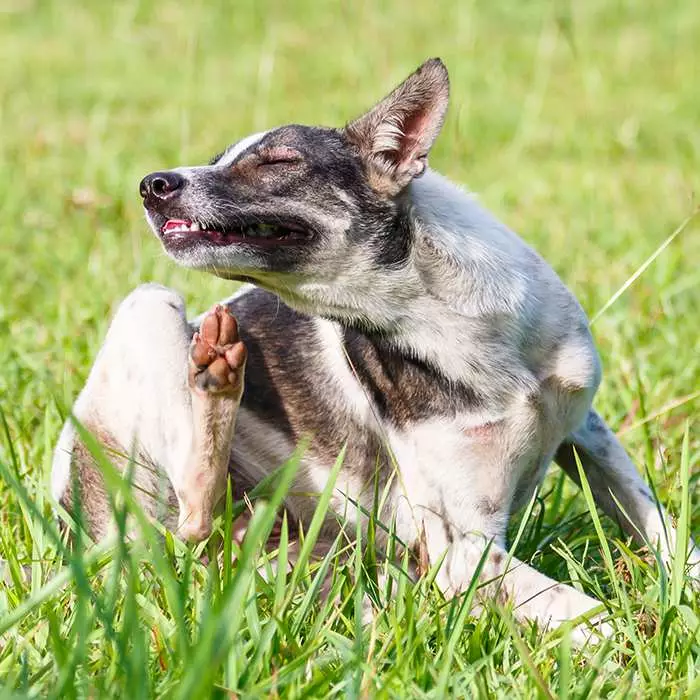
Causes of hair coat and skin conditions
There are many possible underlying causes that can affect the appearance of a dog’s skin and coat, particularly its shine, texture and the extent of shedding. Some of the more common examples include conditions such as hormone or metabolic disorders, digestive disturbances, parasites and cancer. Additionally, conditions that affect mobility, such as arthritis or obesity, can lead to skin problems such as dandruff or matting, if the dog is unable to groom itself properly.
The many and various underlying causes of hair coat and skin conditions in dogs may be broadly categorised as follows:
- External triggers
- Parasitic, bacterial, fungal and yeast infestations
- Abnormal immune reactions / immune-mediated skin diseases
- Systemic diseases; hormonal (endocrine) and metabolic diseases or imbalances
- Hereditary conditions
- Nutritional deficiencies
- Contributing factors
External triggers
Skin inflammation and skin infections can occur in response to certain external triggers – i.e. things in the environment or accidents that affect the skin. Triggers that can set off skin inflammation in dogs include external irritants (e.g. chemicals, thorns, burrs), allergens (e.g. grass, dust mites, foods), burns, and trauma to the skin (e.g. a cut or dog bite).
Parasitic, bacterial, fungal and yeast infestations
One of the most prevalent causes of skin conditions in dogs is parasites, both internal (e.g. intestinal worms) and external (e.g. fleas, ticks, lice, mange mites). Depending on the geographical location, fleas can be extremely common in dogs, some of whom develop an allergic reaction in response to a flea bite, resulting in a flea allergy dermatitis.
Mites are another frequent underlying cause of skin disease in dogs, particularly Demodex canis, which causes demodectic mange, and Sarcoptes scabiei which cause scabies (sarcoptic mange).
Underlying fungal or yeast infections can also lead to skin conditions, for example, ringworm (fungal) and Malassezia dermatitis (yeast).
Bacterial skin infections are also widespread in dogs; however, they are typically a secondary reaction to another underlying condition such as parasites or allergies.
Abnormal immune reactions / immune-mediated skin diseases
When the immune system is compromised, resulting in either an under- or over-activity of immune responses, skin disease can manifest.
Over-active, or hyper-defensive, immune responses include the body’s immune system attacking its own skin, leading to autoimmune skin disorders such as the pemphigus complex, systemic lupus erythematosus (SLE), discoid lupus, atopy (inhalant allergy), and vasculitis.
Under-active immune responses lead to increased susceptibility to mange and recurrent bacterial and/or fungal skin infections. Abnormal immune reactions can lead to the formation of areas of persistent, sterile skin inflammation. Examples of these include sterile pyogranulomas, sebaceous adenitis, puppy strangles, eosinophilic dermatopathies, and injection reactions.
Systemic diseases
A systemic disease is one that affects several organs and tissues, or even the body as a whole. Systemic illnesses include endocrine disorders and hormonal imbalances, as well as metabolic diseases such as diabetes mellitus, renal disease, liver disease.
Some systemic diseases can become symptomatic as a skin disorder; in fact, the skin is often a window to systemic disease (i.e., the skin can be the first part of the body where signs of systemic illness are noted).
Skin and hair coat changes are a common manifestation of hormonal diseases such as hypothyroidism, hyperadrenocorticism (Cushing’s disease), and sex hormone abnormalities, including tumours of the ovaries or testicles.
Early recognition of skin changes as clinical markers of systemic disease is important in expediting diagnosis and treatment of the underlying disorder.
Hereditary conditions
The term “genodermatoses” applies to skin conditions of genetic origin. Dogs can inherit several different kinds of skin disorders; these may be present at birth or may appear later. Many of these diseases are inherited in a recessive pattern, which means affected puppies can be born to seemingly normal parents.
Genetic skin disorders can occur in a wide range of dog breeds, although some manifest with greater frequency in certain breeds. Most of these conditions are uncommon to rare.
Some of the breeds more prone to particular hereditary or congenital skin conditions include:
- Standard Poodles – granulomatous sebaceous adenitis, which affects the oil glands and can cause hair loss and a moth-eaten appearance.
- British Bulldogs – histiocytomas, or skin tumours that appear as a lump on the skin.
- Rhodesian Ridgebacks – Dermoid cysts, skin pockets into which dander, hair, oil, and other debris accumulate.
- Irish Terriers – Familial footpad hyperkeratosis, increased thickness of the hard, outer layer of the skin.
- English Springer Spaniels – Psoriasiform-lichenoid dermatosis, small red lumps on the skin and solid elevated areas near the ears or groin.
- Rottweilers – Vitiligo, bleached splotches of skin on the face, especially the bridge of the muzzle or around the eyes.
- Miniature Schnauzers – Acquired aurotrichia, where the hair along the middle of the back above the spine changes from the normal black or grey to golden.
- Chinese Shar-Peis – Cutaneous mucinosis, where the skin exhibits pronounced folding and blisters.
- Cocker Spaniels – primary disorders of keratinisation
- Terriers – Atopic dermatitis, where exposure to an environmental allergen results in an inflammatory skin response.
Nutritional deficiencies
The nutrients that most commonly affect the quality of skin and coat are protein and fatty acids. Skin and hair, because of their constant renewal, utilise a significant portion of dietary protein; therefore, when there is inadequate or poor-quality protein in the diet, the coat and skin are among the first areas of the body to be affected.
Also affecting the skin and hair coat are deficiencies of vitamin A and zinc, as well as general malnutrition. When the diet is inadequate to meet the dog’s dietary needs, it will have a dull, dry hair coat and will often shed excessively.
Additional contributing factors to skin and hair coat disorders
- Age – distinct age predilections are seen in many skin diseases, e.g., demodicosis and dermatophytosis in paediatric animals; atopic dermatitis in 1–3 yr olds.
- Pruritis – conditions that begin with pruritus may lead to self-trauma and subsequent development of secondary skin lesions (e.g., alopecia, seborrhoea) or infections (bacterial or yeast pyoderma).
- Seasonal change – correlating with fleas, allergic skin disease, or weather-related diseases.
- Stress or excessive boredom
- Frequency of bathing – excessive bathing and wetting of the skin can predispose to skin disease.
- Contact with other animals – contagion with fleas, scabies, cheyletiellosis, or dermatophytosis.
- Environmental conditions – housing conditions can influence the development of certain skin diseases, e.g., contact dermatitis, contagious diseases.
How are hair coat and skin conditions in dogs diagnosed?
It is strongly recommended that hair coat and skin conditions in dogs are evaluated by a veterinarian to determine the cause and establish the correct diagnosis and the most effective form of treatment.
Because there are numerous dog skin conditions with similar symptoms, the underlying cause may not be immediately evident. In this case, the veterinarian will most likely make a differential diagnosis by investigating all the possible disorders that could be causing the symptoms. He or she will rule out each of the more common possible causes until the correct disorder is identified by a process of elimination.
A physical examination, as well as a general history of the dog’s health and a detailed dermatological history will be required. Based on the findings, various tests and/or procedures may be required. An alternative diagnostic approach is to immediately initiate a course of treatment and thereafter evaluate the dog’s response to it. Several consultations may be necessary for an accurate diagnosis to be obtained.
Physical examination
A complete physical examination should always be performed. Many skin diseases are indicators of systemic diseases (i.e. diseases that affect other parts of the body or the entire body). A good dermatologic examination entails a very close inspection of the entire hair coat and skin under strong lighting. It is important to thoroughly examine the dog’s chest and abdomen, where many primary lesions (growths) and cutaneous parasites (those affecting the skin) are found.
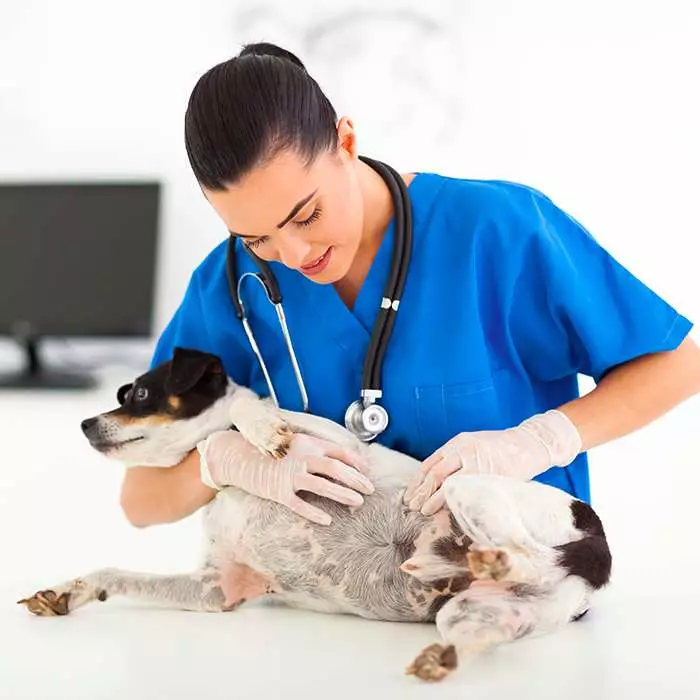
History
A good history is important, because many skin diseases that look similar are differentiated based on interpreting clinical signs in conjunction with historical patterns. General information about prior illnesses, vaccinations, housing, feeding practices, changes in attitude and food consumption, elimination practices, exposure to other animals, and travel within the past 6 to 12 months should be provided.
A detailed dermatologic history is essential in order to interpret the physical examination findings and choose appropriate diagnostic tests. The following dermatological information should be provided:
- Onset and progression of the disease or primary complaint
- Length of time the condition has been present
- Age at which the condition started
- Presence and severity of pruritus (severe itching, characterised by behaviours including licking, rubbing, scratching, or chewing)
- Type and progression of lesions observed by the owner
- Evidence of seasonality
- Area on the body the problem was first noticed
- Any previous treatments for skin conditions and the responses to such
- Presence of fleas, ticks, or mites
Based on the physical examination findings and history, the veterinarian may perform several tests, which could include:
- A complete blood count, biochemistry profile, urinalysis and faecal testing to evaluate general health; however, in most dermatologic cases, these tests do not help to make a definitive diagnosis. If the dog has signs of systemic illness, these tests may help to identify the cause, while in dogs with recurrent infections, they may identify an underlying subclinical disease.
- Skin scrapings, i.e. collecting material from the skin’s surface (superficial) or within the hair follicle (deep), which is sent to a lab for fungal and bacterial cultures (used primarily to determine the presence or absence of mites).
- Cytologic examination of scrapings, to identify bacterial, fungal, and, possibly, neoplastic skin diseases.
- Microscopic examination of skin scrapings and/or hair shafts.
- Combing of the hair coat or “flea combing,” to collect large amounts of skin debris and trap cutaneous parasites such as fleas, ticks, lice, and some mites.
- Bacterial and fungal cultures
- Skin biopsies in cases that appears severe, unusual, or do not respond to appropriate therapy
- Serum immune tests, if an allergy is suspected
- Intradermal allergy testing, in cases of severe and chronic allergic symptoms
- In vitro diagnostic tests (ELISA or RAST tests), as an alternative to intradermal skin testing
- Food elimination trial, if a food ingredient is suspected
- Hormonal assays
Prognosis
Dog hair coat and skin conditions are not usually a life-threatening problem, but they can cause much pain and discomfort. Fortunately, most dog skin conditions are treatable, and in most cases the animal will make a full recovery.
Chronic and recurring conditions without an identifiable cause can pose a more significant problem, as can some underlying systemic disorders, for which lifelong medication may be required. If this is the case, frequent check-ups will be necessary to monitor the dog’s condition and adjust the treatment plan where necessary.
Fortunately, in most cases, carefully following the veterinarian’s instructions will lead to healthy skin, coat, and a happy dog. Therefore it is important to follow through with the treatment plan, including any diet, parasite control, and hygiene recommendations.
Treatment for hair coat and skin conditions
Successful treatment of hair coat and skin disorders requires definitive diagnosis of the specific condition. If the dog’s skin or coat problem is caused by an underlying health issue, the general health of the skin and the quality of the hair should improve dramatically when the illness is brought under control with appropriate treatment.
In many cases, a multimodal treatment approach will be prescribed encompassing two or more types of treatment. These may include:
Topical treatment
Many treatments for skin diseases are applied topically, i.e. directly to the surface of the skin. This may be the only treatment, or it may be prescribed in conjunction with systemic treatment (medications taken by mouth or injected and distributed throughout the body). Clipping or shaving the hair coat may be recommended to allow the topical therapy to reach the skin more easily, making treatment much more effective and shortening the course of the condition.
Topical treatment products can be in the form of ointments, creams, gels, shampoos and sprays. The vet may prescribe, for example, antibiotic ointment, corticosteroid cream, medicated shampoo and/or topical insecticide. It is essential to closely follow instructions for all topical medications; they should be used sparingly so that the dog does not lick off – and ingest – excessive amounts of the substance, which may be toxic and/or induce vomiting.
Medicated shampoos are frequently used for specific skin conditions, including antimicrobial and antiseborrheic products. Regular application of a medicated shampoo is very important; often as much as 2 to 3 times per week initially. Usually, the dog is first washed with a cleansing shampoo and then rinsed well. The medicated shampoo is diluted according to the application instructions and then applied evenly to the coat. The shampoo should remain on the skin for about 10 minutes before it is thoroughly rinsed off.
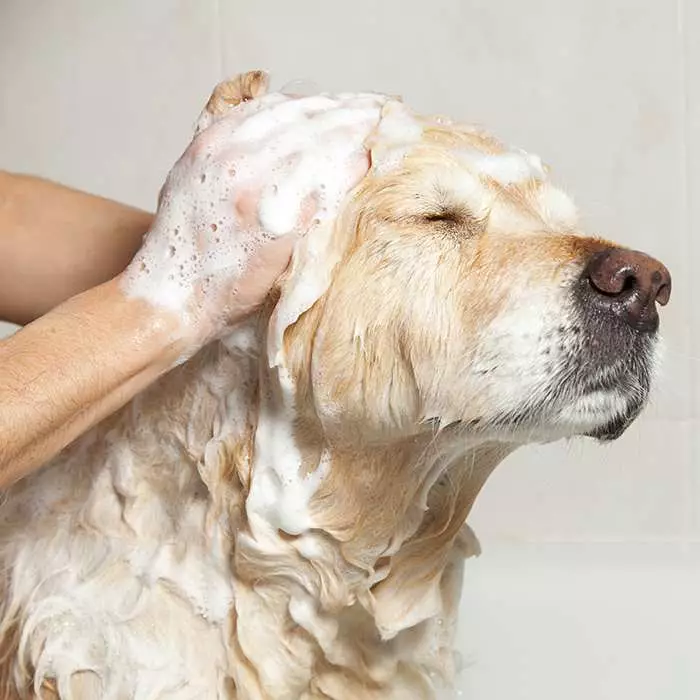
Medication / drug therapy
Systemic drugs may be prescribed by the veterinarian to treat some skin and haircoat disorders. These include whole-body antibiotics, antifungals, antiparasitics, hormones, antihistamines, corticosteroids and other anti-inflammatory drugs. These should always be administered according to the vet’s instructions.

Dietary modification and supplementation
In order to maintain the skin and hair in a healthy state, a properly balanced diet containing high quality digestible proteins, carbohydrates, fats, minerals and vitamins, as well as enough calories to meet the animal’s energy needs, is required. Therefore, treatment may include dietary changes and/or dietary supplementation.
For nutritional deficiencies of specific vitamins, such as vitamin A, vitamin E or zinc, supplements will be prescribed. For more broad nutritional deficiencies caused by general malnutrition, a balanced diet and a supplement of essential fatty acids may be prescribed. Some dogs are more sensitive than others, but all dogs benefit greatly from a healthy diet that does not contain an abundance of filler or artificial ingredients.
Skin tumour treatment
Benign skin tumours are often left alone as these may regress spontaneously. Alternatively, they can be surgically removed if they are bothering the dog or are likely to grow bigger. This can be done by surgical excision or cryosurgery (performed with a laser). They can also be treated with topical steroids and antibiotics if they ulcerate, become inflamed or infected.
Treating the underlying condition
In most cases, the skin condition will improve once the underlying condition has been identified and properly treated. This may entail specific medication to treat a systemic disorder such as hypothyroidism or Cushing’s disease. Different types of treatment may be required depending on the underlying cause of the condition, for example:
Treatment of alopecia:
Depending on its underlying cause, treatment may entail:
- Flea control
- Antibiotics, for skin infections
- Various treatments of skin allergies
- Medication for hormonal conditions (long-term treatment)
- Treatment for joint pain resulting from over-grooming
Treatment of scaly skin
Depending on its underlying cause, treatment may entail:
- Topical products, such as medicated shampoos (salicylic acid and benzoyl peroxide aid in cell turnover), or dips
- Targeted medication to prevent and treat parasites or infections
- Antibiotics for bacterial skin infections
- Antifungal drugs for fungal infections,
- Stronger antiparasitic drugs if topical treatments are not strong enough
Preventative measures
- Regular grooming is encouraged to remove loose hairs and dead skin cells, to keep the coat free of dirt, debris, and external parasites, and to distribute natural skin oils along the hair shafts (frequency of brushing will depend upon your dog’s breed, skin and coat).
- Elizabethan collars may be used to prevent scratching of the head and face.
- Nails can be clipped, and socks can be put on the hind feet, to reduce trauma from scratching.
- Keeping the hair clipped short during summer is recommended.
- Frequent bathing, if indicated and depending upon your dog’s breed and specific skin and coat; a medicated or hypoallergenic shampoo may be prescribed.
- Following a strict flea control program.
- Frequent skin checking to help detect any unusual lumps and bumps, parasites such as fleas and ticks, or areas of sensitivity on your dog’s body.
- If indicated, keeping exposure to sunlight to a minimum, for e.g. in cases of Collie nose.
- Applying sunscreen lotions may help but can have limited effectiveness because of licking.
- Tattooing of permanent black ink into the affected areas as a shield against sunlight (young dogs with lightly pigmented noses can be tattooed before any lesions develop).
- Keeping the dog’s environment clean and hygienic.
In summary
The dog’s skin is its largest organ. Most of the skin is covered by hair, which plays an important role in protecting the skin. While the type and length of hair coat varies widely between breeds, the general condition of the dog’s skin and coat are good indicators of its health. There are many different skin and hair coat conditions that can affect dogs, as well as many underlying conditions can negatively impact the dog’s skin and hair.
Skin and hair coat conditions in dogs are evident by symptoms such as hair loss, dry patches, excessive shedding, lesions and redness and by behaviours such as constant scratching and excessive licking. A precise diagnosis of the condition requires a detailed history, physical examination, and appropriate diagnostic tests. Resolution of skin and hair coat disorders requires that the veterinarian identifies and treats the underlying cause. In most cases, the prognosis for recovery is good.
Bow Wow Meow Pet Insurance can help protect you and your dog should an unexpected trip to the vet occur.
-
Find out more about our dog insurance options
-
Get an online pet insurance quote


More information
https://vcahospitals.com/know-your-pet/coat-and-skin-appearance-in-the-healthy-dog
http://www.animalplanet.com/pets/healthy-pets/dog-skin-disorders/
https://www.msdvetmanual.com/dog-owners/skin-disorders-of-dogs/
https://www.petmd.com/dog/conditions/skin/c_dg_scaling_skin
https://moderndogmagazine.com/articles/common-canine-skin-conditions/97723
https://wagwalking.com/condition/bacterial-infection-of-the-skin
https://www.petmd.com/dog/conditions/skin/c_dg_sebaceous_adenitis
https://wagwalking.com/condition/scaly-skin
https://www.diamondpet.com/blog/health/sensitive-skin/dogs-skin-coat-layer/
https://www.msdvetmanual.com/dog-owners/skin-disorders-of-dogs/structure-of-the-skin-in-dogs
https://www.msdvetmanual.com/dog-owners/skin-disorders-of-dogs/diagnosis-of-skin-disorders-in-dogs
https://www.msdvetmanual.com/dog-owners/skin-disorders-of-dogs/treatment-of-skin-disorders-in-dogs
https://www.msdvetmanual.com/integumentary-system/integumentary-system-introduction/alopecia
https://wagwalking.com/condition/black-hair-follicular-dysplasia
https://www.petmd.com/dog/conditions/skin/c_dg_histiocytoma
https://wagwalking.com/cat/condition/acute-moist-dermatitis
https://wagwalking.com/condition/epidermolysis-bullosa
https://vcahospitals.com/know-your-pet/seborrhea-in-dogs
https://www.petmd.com/dog/conditions/skin/c_dg_dermatophytosis





